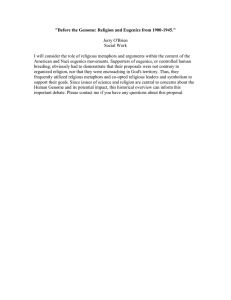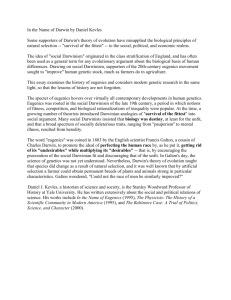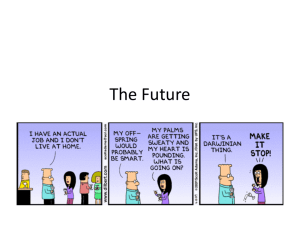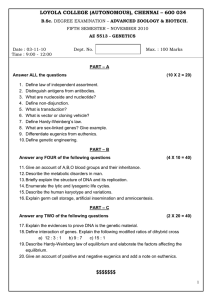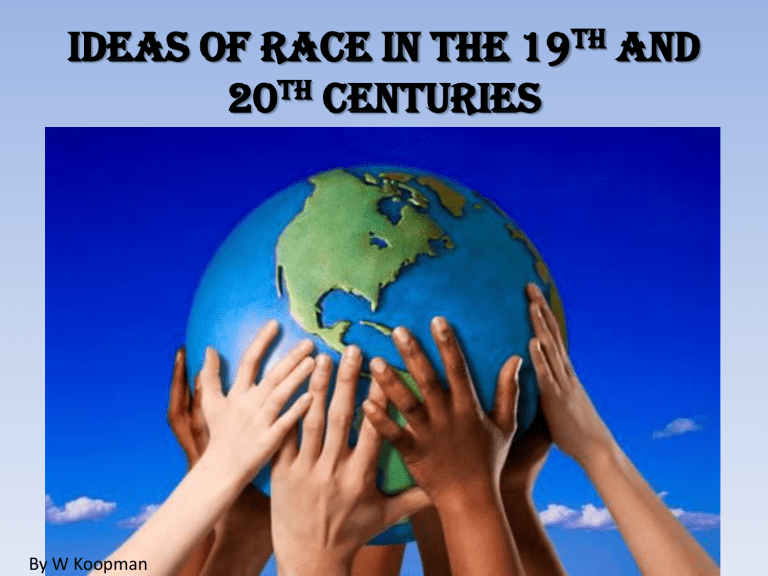
Ideas of race in the 19th and 20th centuries By W Koopman What is RACE? • A group of people who are similar because they speak the same language or have the same history or customs. • Identify “racial” groups within the class. Pseudo Science • What is it? • Definition: A theory, methodology, or practice that is considered to be without scientific foundation. • Examples? • Two theories: Scientific Racism and Social Darwinism • Theories about RACE • Its origins? Darwinism / Charles Darwin Origin of Species: 1859 “Multiply, vary, let the strongest live and the weakest die.” Charles Darwin, The Origin of Species Darwinism • A theory of biological evolution developed by Charles Darwin and others, stating that all species of organisms arise and develop through the natural selection of small, inherited variations that increase the individual's ability to compete, survive, and reproduce • What does this mean practically? Theories based on the pseudo science: 1. Scientific Racism 2. Social Darwinism Scientific Racism • It was based on the study of various human beings throughout the world and the categorisation of these people into racial groups. • People were categorised according to their physical features and in later years this would be used to suggest that these various races had varying mental abilities. Social Darwinism • Social Darwinism does not believe in the principle of equality of all human beings. It states that: • Some human beings are biologically superior to others • The strongest or fittest should survive and flourish in society • The weak and unfit should be allowed to die Social Darwinism Saartjie Baardman • Saartjie Baartman was born in 1789 into the Griqua tribe of the eastern Cape, a subgroup of the Khoisan people who are now thought to be the first aboriginal inhabitants of the southern tip of Africa. Her family moved to a shack near Cape Town and, while working as a 20-year-old servant to a local farmer, she attracted the attention of a visiting English ship's surgeon, William Dunlop. What made her a curiosity in the doctor's eyes were her extraordinary steatopygia — enlarged buttocks — and her unusually elongated labia, a genital peculiarity of some Khoisan women of the time. • She agreed to go with Dunlop to England where, he promised her, she would become rich and famous as a subject of medical and anthropological research. She was 21 when she left Cape Town for London. At first, she was indeed put under anatomical scrutiny by scientists, who named her genital condition the 'Hottentot apron'. 'Hottentot' was a word coined by early Dutch settlers to South Africa to describe the strange clicking language of the Khoisan. But the only success she achieved was as an exhibit before the general public. • Contemporary descriptions of her shows at 225 Piccadilly, Bartholomew Fair and Haymarket in London say Baartman was made to parade naked along a "stage two feet high, along which she was led by her keeper and exhibited like a wild beast, being obliged to walk, stand or sit as he ordered". People paid one shilling to gawk at her, where she was depicted as a wild animal in a cage, dancing for her keeper. For several years, working-class Londoners crowded in to shout vulgarities at the protruding buttocks and large vulva of the unfortunate woman. • The aristocracy were no less fascinated at what they saw as a sexual freak, but they had private showings. Baartman was supposed to earn half of the proceeds from her performances, but in fact she saw little of the profits. In 1814, after spending four years being paraded around the streets of London, Baartman was taken to Paris and, according to the archival accounts, was handed to a "showman of wild animals" in a travelling circus. Her body was analysed by scientists, including Baron Cuvier, one of Napoleon Bonaparte's surgeons. A number of pseudo-scientific articles were written about her, testimony at the time to the superiority of the European races. • Her anatomy even inspired a comic opera in France. Called "The Hottentot Venus" or "Hatred to French Women", the drama encapsulated the complex of racial prejudice and sexual fascination that occupied European perceptions of aboriginal people at the time. It appears Baartman worked as a prostitute in Paris and drank heavily to cope with the humiliation she was subjected to. Sad and homesick, she died a lonely alcoholic on January 1 1816, probably of pneumonia. But even then she was to suffer indignity. Less than 24 hours after her death she was carved up by Baron Cuvier. He had her body cast in wax, dissected and her skeleton articulated. Her genitalia and brain were pickled and displayed at the Musee de l'Homme (Museum of Mankind). They were finally withdrawn from public view in 1974, and her remains were assigned to a storeroom and forgotten. • But some Africans never forgot Baartman. Nelson Mandela made a request to France in 1994 for her remains to be handed back. Her cause gained momentum amid post-apartheid South Africa's new awareness of tribal identity. All over the country, aboriginal peoples are asserting their heritage rights, claiming not only political and cultural recognition, but also the restitution of ancestral land and the protection of intellectual property rights. The San, once known as the bushmen of southern Africa, have successfully reclaimed historic tribal land and won a share in the proceeds of internationally marketed drugs made from their traditional medicinal plants. And now Baartman's Khoisan tribe, which has been recognized by the United Nations as an indigenous "First Nation," has won a victory for tribal recognition by securing the return of the 'Hottentot Venus' to South Africa. Ota Benga Class debate: There is substance for these theories? Eugenics • "Eugenics is the study of the agencies under social control that may improve or impair the racial qualities of future generations either physically or mentally." Sir Francis Galton, 1904 • Eugenics, meaning "well born," was introduced in the 1880s by Sir Francis Galton, a cousin of Charles Darwin and the father of modern statistics. • Galton pioneered the use of pedigrees, twin studies, and statistical correlation for the purpose of using that knowledge to improve "the breed of man.“ • the study of or belief in the possibility of improving the qualities of the human species or a human population, especially by such means as discouraging reproduction by persons having genetic defects or presumed to have inheritable undesirable traits (negative eugenics) or encouraging reproduction by persons presumed to have inheritable desirable traits (positive eugenics) Francis Galton Eugenics in Australia Colonisation of Australia • • • • • • Aborigines – 70 000 years Hunter-gatherers Beliefs 1788 – Sydney – Originated from a penal colony Penal Colony – Convicts Industrial revolution and lack of opportunities in Britain • Fear of the French • Increase of Settlers Australian Federation in 1901 Conditions for the Aborigines • No longer hunter gatherers • Dependent on the settlers for the livelihood as their land was redistributed. • Many died because of the diseases introduced by the Europeans, due to lack of immunity, especially smallpox. (trend throughout the world due to colonialism) • Guerilla warefare in Tasmania • Some historians argue that it was a genocide, even though it was not a formal British policy. Debate of race in Australia • 1 million Aborigines originally, but down to 60 000 by the early 20th century! • Racial Decay – Settlers used Social Darwinism to reason that the Aborigines were unable to adapt and were inferior. Therefore the decline. • Racial Suicide – If Aborigines refused to adapt to the new social structure and means of production. • What should be done? • 1. Isolation. 2. Integration/ Assimilation. 1. 2. 3. Government Intervention: Laws 4. Aborigines and half castes moved to reserves against their will. Not allowed to vote, drink alcohol, carry guns or own dogs. Marriages between white people and Aborigines needed special permission from a government minister. Superintendants had control over reserves and all aspects of Aborigines lives. Eg. Read letters, dormitories for children, confiscate property, ban traditions and customs, expulsion. “Protectors of Aborigines”. White Immigration Policies • Favoured English speaking immigrants, exclusively. • Mostly from the USA, Canada and Britain. • There was a need for farm workers and domestic workers. • These were not popular jobs and most immigrants moved to town in the hope of better jobs. • This was another form of discrimination The Stolen Generation • 100 000 half caste children moved from their parents. Most had an aborigine mother and white father. 1910-1970. • Removed from mothers and sent to live with white families, missionaries or orphanages. • Forced to assimilate and not allowed contact with the ‘real’ families. • Trained as domestic workers and farm workers. Missionary schools When Ruth was 4 years old, she was separated from her mother on Cherbourng mission in Queensland. Ruth was 6 months old when she first arrived at Cherbourg. Times were tough; it was during the Depression, and Ruth’s mother had gone to Cherbourg seeking help for her ageing parents. Ruth’s Story But once she arrived at the mission, Ruth's mum was prevented from leaving. What was intended as a temporary visit became years of separation and control. “People would say it was for your own good, but my own good was to stay with my mum,” says Ruth. At first Ruth was allowed to stay with her mum in the women’s dormitory. But eventually every child was removed to a separate dormitory. Ruth was 4 when she was taken from her Mum. “Once you were taken from your parents, you had no more connection with them,” she explains. For a short time, Ruth still saw her Mum from a distance. But when Ruth was 5, her mother was sent away from Cherbourg and forced to leave her daughter behind. Ruth’s Story https://australianstogether.org.au/discover/australianhistory/stolen-generations#video-1 The Aim of Eugenics, Eugenics Society. 1934. THE AIM OF EUGENICS • The aim of Eugenics is to study the laws of heredity as they apply to human beings, with the practical purpose of using this knowledge for improving the physical and mental quality of the race. Eugenists believe that no child should be born into the world who is unlikely to have a fair chance. They affirm, therefore, that anyone, man or woman, who undertakes the serious responsibility of parenthood, must be free from any disease, mental defect, or other disability that is likely to be passed on by heredity and so impair the quality of future generations. Most intelligent people now share this view; indeed, many have too few children, because they wish to give the best care and attention to each child. But the nation is endangered when fit people refuse to have children for selfish reasons. Our country needs the best citizens it can produce. • Positive Eugenics: But if it is agreed that people who are sound in body and mind should have as many children as they can afford to bring up, it follows that people who are ill endowed in body or mind, and whose offspring are liable to be unhealthy or subnormal, should avoid having children. • The next generation should be recruited from good stocks rather than from bad. But exactly the opposite is now happening, for it is among the fittest stocks that the birth rate is lowest and among the unfit that it is highest. We should not be content to allow this to continue. We should encourage the fertility of persons likely to produce healthy children, and at the same time prevent the waste and misery caused by the birth of children who are healthy neither in mind nor in body. • These policies deserve the serious consideration of every citizen and especially of young people who are entering on adult life and beginning to realize its responsibilities. “Breed blackness out” • Two government officials: Cecil Cook (Northern Territories) and Auber Neville (Western Australia). Protectors for decades. • Forced removals of mixed-race children from their mothers. Ruthlessly. • Insisted that these children be allowed to marry white Australians. Children from such marriages would be classified as white. • Close control by both men, administratively. Education, clothing, etc. • Especially girls, who would not be allowed to marry Aborigines, but only white men or other mixed races. Eugenics in the USA Eugenics plan for the USA Follow link. • Reservations • Segregation • Scientists – Charles Davenport and psychologist – Henry Goddard - Encouraged government to promote genetic improvement • Migration of African-Americans to northern states cities. • Sterilisation of criminals (Indiana the first state 1907) • 60 000 forcibly sterilised in the space of 50 years Ellis Island Eugenics in South Africa • • • • • Apartheid Segregation Experiments Homelands Poor white phenomena Homosexuality • • • • • The Aversion Project in South Africa (1970s-1980s)[edit source] In a project headed by Dr. Aubrey Levin South Africa’s apartheid army forced white lesbian and gay soldiers to undergo ’sex-change’ operations. It was part of a secret program to purge homosexuality in the army. This was supported by psychological treatment by army psychologists. Many had to undergo to chemical castration, electric shock, and other unethical medical experiments if they could not be 'cured' with drugs. An estimated 900 forced ’sexual reassignment’ operations may have been performed between 1971 and 1989 at military hospitals. Many of these experiments were conducted at the Military Hospital at Voortrekkerhoogte. Many of the victims were young, 16 to 24-year-old white males drafted into the apartheid army although a few women did have to undergo experimentation.[ Dr. Aubrey Levin is now Clinical Professor in the Department of Psychiatry (Forensic Division) at the University of Calgary’s Medical School and a member at the College of Physicians and Surgeons of Alberta. Nazi German Germany • 1933 • Reichstag and communists • President and Prime Minister • Gestapo (Secret Police) and SS • Concentration Camps Propaganda • • • • • • Teachers had to join the Nazis Teachers League. Anti Nazi books burned. Only pro Nazi media. Hitler Youth – Children motivated to join. Gestapo (secret police) crushed opposition. SS (Hitlers personal bodyguard) brutal acts. A branch of the SS controlled the concentration camps. • Structure, discipline and patriotism demanded from all, especially from soldiers who swore an oath to Hitler. • Every schoolbook was an illustration of Hitler with one of his sayings on the front page. German Schools • "Learn to sacrifice for your fatherland. We shall go onwards. Germany must live. In your race is your strength. You must be true, you must be daring and courageous, and with each other form a great and wonderful comradeship." German Nation, Aryan Race • • • • Master Race and Ubermensch. Separation, sterilization and extermination Negative and Positive Eugenics Specific groups targeted. Black people, homosexuals, Slavs, criminals, mentally ill, Roma and the Jews. • • T4 • • • In the fall of 1939 the German government established, under the Reich Chancellery, the Euthanasia Programme under the direction of Philip Bouhler and Dr. Karl Brandt. The headquarters of the operation were at Tiergartenstrasse 4, Berlin and the code name for the program was derived from that address—T-4. The choice of terminology for the program is consistent with the Nazis’ use of euphemisms. Euthanasia typically means "mercy killing" and in the 1990's in the United States and other western nations, it is synonymous with "physician-assisted suicide." The kind of killing carried out through the T-4 program bears little resemblance to contemporary concepts of euthanasia. The cost of the disabled: Nazi propaganda Final Solution Boycott Jewish businesses. June 1933, Jews dismissed from the civil service 1935 Nuremburg Laws. Solution Kristallnach, November 1938. WW2 and the Ghettos of Eastern Europe, Warsaw in particular. 450 000 people living in an area of 100 000 capacity. Death camps. 1945-1949 13 Trials November 1945-October 1946 – Main Trials Josef Mengele – White angel of death Genome Project • The Human Genome Project (HGP) was the international, collaborative research program whose goal was the complete mapping and understanding of all the genes of human beings. All our genes together are known as our "genome." • The HGP was the natural culmination of the history of genetics research. In 1911, Alfred Sturtevant, then an undergraduate researcher in the laboratory of Thomas Hunt Morgan, realized that he could - and had to, in order to manage his data - map the locations of the fruit fly (Drosophila melanogaster) genes whose mutations the Morgan laboratory was tracking over generations. • Sturtevant's very first gene map can be likened to the Wright brothers' first flight at Kitty Hawk. In turn, the Human Genome Project can be compared to the Apollo program bringing humanity to the moon.
